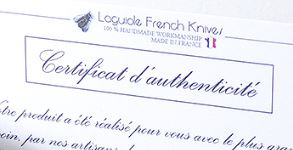- -20%
Laguiole knife with Gold tinted mammoth molar handle
$919.35
Save 20%Laguiole knife and folding - Savage edition One off
- Handle made with Mammoth molar tinted
- 2 stainless steel bolsters
- Forged bee and spring, hand guilloched
- Damascus stainless steel
- 22cm opened (8.7in) - 12cm closed (4.7in)
Type : Laguiole knife and folding - Savage edition
Raw material of the handle : Handle made with tinted mammoth molar.
Blade : Stainless Damascus steel blade 150 Layers of a thickness of 3 mm to the stub.
Spring : Bee and spring forged. Hand guilloched/chiseled spring.
Plates : 2 Hand guilloched/chiseled plates, indented with ebony wood wafers of 2mm.
Bolster : 2 inox bolsters.
Dimensions & Weight : 22cm Open (8.7in), 12cm (4.7in) Closed, in average 100-110g.
No dishwasher
Delivered with certificate of authenticity
This Laguiole knife is handmade in the Laguiole Le Fidèle workshops near Thiers, France.
It is unique, and the creation process requires over 170 manual operations by the craftsmen.
Mammoth molar handle
Fossil mammoth molars for making Laguiole knife handles: A fusion of history and function
Mammoths, those majestic prehistoric giants, continue to captivate researchers and paleontology enthusiasts worldwide. However, their influence extends far beyond museums and natural history books. Fossil mammoth molars have found a new life in contemporary craftsmanship, especially in the world of Laguiole knives.
The extraction of fossil mammoth molars is a delicate and demanding endeavor that often begins with paleontological expeditions. These expeditions typically take place in regions of the world where mammoths once roamed, such as Siberia, Alaska, and northern Canada. Experts search for mammoth remains preserved in permafrost, permanently frozen soil, as this is where the molars are best preserved.

Once located, the molars are carefully unearthed from the ice and soil. This process requires great care to avoid damaging these precious relics of the past. Research teams use specially designed tools to excavate the teeth with the utmost care.
Once extracted, fossil mammoth molars are often in poor condition. The fossilization process, which spanned thousands of years, has made them porous and fragile. To prepare them to become Laguiole knife handles, they must be stabilized.
Stabilizing fossil mammoth molars typically involves immersing them in a special resin. This resin penetrates the tooth's pores and strengthens them, making them stronger and more durable. This also helps prevent future degradation.
Once stabilized, the molars can be dyed to enhance their appearance. Dyeing serves to highlight the natural patterns and details of the tooth. The most commonly used colors are black, brown, and blue, but other colors can be employed to create unique effects.
 Stabilized and dyed fossil mammoth molars are highly prized by artisan makers of Laguiole knives, due to their unique appearance and remarkable properties.
Stabilized and dyed fossil mammoth molars are highly prized by artisan makers of Laguiole knives, due to their unique appearance and remarkable properties.
Fossil mammoth molars offer an unparalleled aesthetic appeal. Natural patterns that form over time within the tooth, such as lines and curves, impart each piece with natural and one-of-a-kind beauty. The artisan makers of Laguiole knives often incorporate these patterns into the design of their Laguiole knife handles to create functional works of art.
Once stabilized, fossil mammoth molars become incredibly strong. They withstand daily wear and tear well, making them an ideal material for Laguiole knife handles. Laguiole knives with handles made from fossil mammoth molars are appreciated for their resilience and longevity.
The use of fossil mammoth molars to make Laguiole knife handles establishes a direct connection to the planet's history. These teeth have survived for thousands of years and carry ancient stories within them. Laguiole cutlers who use this material pass down this history through their creations, thus creating unique objects imbued with significance.

In conclusion, fossil mammoth molars are more than mere fossils. They serve as tangible testimonies of the past and a source of inspiration for contemporary Laguiole knife makers. Their extraction, stabilization, and dyeing are delicate processes that preserve their integrity while showcasing their natural beauty. Using these molars for Laguiole knife handles production creates exceptional pieces that combine aesthetics, durability, and history, reviving a piece of the prehistoric world in every crafted Laguiole knife.
Data sheet
- Handle raw material
- Additional ebony wood plates
Mammoth molar - Blade type
- Damascus stainless steel
- Bolsters
- Stainless steel (x2)
- Spring
- Forged bee on forged and guilloched spring
- Folding knife
- Yes
- Corkscrew
- No
You might also like




































